Scheduled monuments in Lancashire
This is a list of Scheduled Monuments in the English county of Lancashire.
In the United Kingdom, a scheduled monument is a "nationally important" archaeological site or historic building that has been given protection against unauthorised change by being placed on a list (or "schedule") by the Secretary of State for Culture, Media and Sport; English Heritage takes the leading role in identifying such sites.[1] Scheduled monuments are defined in the Ancient Monuments and Archaeological Areas Act 1979 and the National Heritage Act 1983. They are also referred to as scheduled ancient monuments. There are about 20,000 Scheduled Monument entries on the list, which is maintained by English Heritage; more than one site can be included in a single entry.
While a scheduled monument can also be recognised as a listed building, English Heritage considers listed building status as a better way of protecting buildings than scheduled monument status. If a monument is considered by English Heritage to "no longer merit scheduling" it can be descheduled.[2]
Lancashire has over 130 Scheduled Monuments including burial mounds, Roman remains, medieval sites, mining relics, castles and various bridges.[3]
| Image | Name | Feature | Location | Notes |
|---|---|---|---|---|
| Ashnott lead mine and lime kiln | Mining | Newton In Bowland, Ribble Valley | Lead mining site since at least the 1500s. Earthwork and buried remains of the surface workings and mine shafts.
Site is at Ashnott Farm, Slaidburn Road | |
| Askew Heights prehistoric enclosure | Enclosure | Quernmore, Lancaster | Univallate (single-walled) defended enclosure (c.70m across) with a track in a deep cutting. Located on a hilltop overlooking the River Lune valley. | |
| Badger Hole, Warton Crag | Warton, Lancaster | |||
| Bailey Hall and chantry of St John the Baptist | Moated site | Aighton, Bailey and Chaigley, Ribble Valley | Remains of late C16th Bailey Hall's moated site with fishponds and the ruins of the early C14th Chantry of St John the Baptist. | |
| Beadle Hill Romano-British farmstead | Settlement | Briercliffe, Burnley | An earth and stone rampart and ditch around a hilltop farmstead enclosure about 75m square. | |
Carters big kiln North tunnel |
Bellmanpark lime kilns and tramway | Kilns | Clitheroe, Ribble Valley | Remains of lime kilns and associated short tramway. James Carter and William Rowe opened the limeworks in c.1869. The row of lime kilns were built in 1877 next to the Chatburn to Blackburn railway line.
180m NW of Bellman Farm |
| Bleara Lowe round cairn | Cairn | Lothersdale, Craven, North Yorkshire | ||
 Bleasdale Circle |
Bleasdale Circle | Henge | Bleasdale, Wyre | On a flat hilltop between the tributary streams of the River Brock. A grave and cremation urns were found in the central mound, around which 11 oak posts formed a ring c.11m across. The Bronze Age urnfield is enclosed by a ditch and a palisaded timber ring c.50m in diameter. |
| Boar's Den bowl barrow | Burial mound | Wrightington, West Lancashire | ||
| Bomber Camp Romano-British farmstead and associated enclosure | Settlement | Bracewell and Brogden, Pendle | C4th farmstead within an enclosure c.70m square, surrounded by a ditch with innner and outer banks. | |
| 2 Bowl barrows at Aighton | Burial mound | Aighton, Bailey and Chaigley, Ribble Valley | 170m NW and 250m North of Hacking Boat House | |
| 2 Bowl barrows at Briercliffe | Burial mound | Briercliffe, Burnley | 140m and 155m East of Beadle Hill | |
| Bowl barrow at Briercliffe | Burial mound | Briercliffe, Burnley | 90m East of Twist Castle | |
| Bowl barrow east of Brown Hills Beck | Burial mound | Gisburn Forest, Ribble Valley | ||
| Bowl barrow on Hameldon Pasture | Burial mound | Worsthorne-with-Hurstwood, Burnley | ||
| Bowl barrow west of Brown Hills Beck | Burial mound | Easington, Ribble Valley | ||
| Bradley Hall | Moated site | Eccleston, Chorley | Moated site with fishponds connected by water channels. Moated sites were typically built between 1250-1350. | |
| Bretters Farm moated site and two fishponds | Moated site | Heath Charnock, Chorley | ||
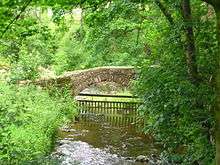 Packhorse bridge at Brooks Farm, Bleasdale |
Brooks Farm packhorse bridge | Bridge | Bleasdale, Wyre | |
 Burscough Priory Ruins |
Burscough Priory | Building | West Lancashire | Burscough Priory was established in c.1190AD by Robert Fitz Henry (Lord of Lathom and Knowsley). The Augustinian priory was dedicated to St Nicholas. The building was destroyed during the dissolution of the monasteries between 1536 and 1541. |
| Burwains Camp prehistoric defended settlement | Settlement | Briercliffe, Burnley | Circular hilltop enclosure c.45m across, surrounded by a ditch and a bank.
West of Broad Bank Hill in Thursden Valley. | |
| Camp House moated site, moated outwork and connecting channels | Moated site | Hornby-with-Farleton, Lancaster | ||
| Castercliff small multivallate hillfort | Fort | Nelson, Pendle | ||
| Castle Haugh Ringwork, Newsholme | Castle | Newsholme, Ribble Valley | ||
| Castle Hill motte | Castle | Penwortham, South Ribble | ||
| Castle Hill motte and bailey, Halton | Castle | Halton-with-Aughton, Lancaster | ||
| Castle Hill motte, Dolphinholme | Castle | Ellel, Lancaster | ||
| Castle Hill prehistoric defended enclosure | Castle | Leck, Lancaster | ||
| Castle Mound motte and bailey, Melling | Castle | Melling-with-Wrayton, Lancaster | ||
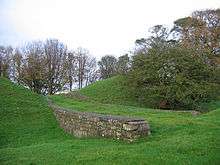 Entrance to the motte and bailey castle |
Castle Stede motte and bailey, Hornby | Castle | Hornby-with-Farleton, Lancaster | |
| Chapel Hill Motte, Arkholme | Castle | Arkholme-with-Cawood, Lancaster | ||
| Chingle Hall moated site | Moated site | Whittingham, Preston | ||
| Claughton hlaew in Sandhole Wood | Burial mound | Claughton, Wyre | ||
 Clintsfield Colliery Engine House |
Clintsfield Colliery | Mining | Tatham, Lancaster | Colliery dating back to c.1800, South of the River Wenning. The structures of the steam engine house, boiler house and chimney are still standing. There are also three reservoirs with dams.
250m East of Clintsfield Farm |
Clitheroe Castle Keep |
Clitheroe Castle | Castle | Clitheroe, Ribble Valley | Early medieval castle in Clitheroe, probably built in the twelfth century. Property of the de Lacy family. The castle site remained in private ownership until 1920. The keep is the second smallest surviving stone-built keep in England. |
 Remains of Cockersand Abbey |
Cockersand Abbey | Building | Thurnham, Lancaster | The remains of Cockersand Premonstratensian Abbey, founded in 1190. All that remains is the restored Chapter House and some ruined masonry. |
| Cromwell's Mound Civil War fieldwork | Military | Preston | ||
| Cross Hall moated site | Moated site | Ormskirk | Earthworks and buried remains of Cross Hall moated site. Cross Hall was a residence of the Stanley family. | |
 Yarrow Bridge at Croston |
Croston Town Bridge | Bridge | Croston, Chorley | Yarrow Bridge crosses the River Yarrow in Chorley. The bridge carries the A6 road over the river and has existed since the late 17th century. |
| Dog Holes Cave | Cave | Warton, Lancaster | ||
| Dovecote at Great Eccleston | Building | Great Eccleston, Wyre | 150m NE of Gradwells | |
| Downham lime kiln and associated lime yard | Kilns | Downham, Ribble Valley | 50m North of Smithfield Farm | |
 Edisford Bridge over the River Ribble |
Edisford (or Eadsford) Bridge | Bridge | Clitheroe, Ribble Valley | The original sandstone bridge, built in 1339, was the only bridge over the River Ribble to the North of Preston until the 1600s. It was widened in the 1800s but retains its main medieval structure.[4] |
| Earthworks in Spa Roughs Wood | Earthwork | Lathom, West Lancashire | ||
 Market Cross at Garstang |
Garstang market cross | Cross | Garstang | |
| Glass melting and annealing workshop | Building | Lancaster | Part of Shrigley and Hunt's stained glass manufacturing workshops | |
Glasson Dock |
Glasson Dock | Dockyard | Thurnham, Lancaster | Due to the difficulty of navigation up the River Lune to the docks in Lancaster, the port commission decided to build a dock at Glasson, which opened in 1787. |
 Greenhalgh Castle Ruins |
Greenhalgh Castle | Castle | Barnacre-with-Bonds, Wyre | Site of Greenhalgh manor house with farming terraces SE of the castle. |
| Halsall medieval rectory | Building | Halsall, West Lancashire | A medieval C14th or C15th priest's house (also known as Halsall Abbey or Halsall Priory) near St Cuthbert's Church. Remains of standing sandstone walls. | |
| Hameldon Hill World War II bombing decoy | Military | Dunnockshaw, Burnley | 390m North of Heights Farm | |
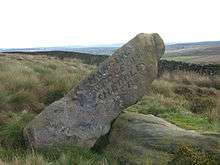 Hanging Stone |
Hanging Stone or Watersheddles Cross | Cross | Laneshaw Bridge, Pendle | Medieval boundary stone near Scar Top on the moorland border between Lancashire and Yorkshire. Records from 1327-77 show that `Waterschedles crosse' was used to mark the boundary between the diocese of York and the diocese of Lichfield.[5]
NE of Watersheddles Reservoir |
 Site of Hapton Castle |
Hapton Castle | Castle | Hapton, Burnley | Buried remains of medieval castle dating back to 1328. The Lords of Hapton lived here until Hapton Tower was built in 1510. The castle was still in use until 1667. By 1725 it was in ruins and little was left of the structure by 1800.
Immediately East of Castle Clough gorge. |
| Headless Cross, Grimeford | Cross | Anderton, Chorley | ||
 Saxon Cross |
High cross in St Peter's churchyard, Heysham | Cross | Lancaster | |
 Halton Viking Cross |
High cross in St Wilfrid's churchyard, Halton | Cross | Halton-with-Aughton, Lancaster | |
Higher Mill and Chimney |
Higher Mill, Helmshore | Building | Rossendale | |
 Higherford Old Bridge, Barrowford |
Higherford Old Bridge | Bridge | Barrowford, Pendle | Also known as Packhorse Bridge, spans over 12m across Pendle Water. Built around the end of C16th or early C17th for carrying coal by packhorses from the Gisburn area. |
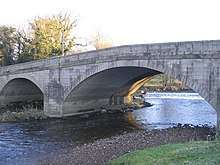 Bridge over the River Wenning at Hornby |
Hornby Bridge | Bridge | Hornby-with-Farleton, Lancaster | |
| Ice house at Towneley Hall | Building | Burnley | Located at Towneley Park | |
 Site of Ightenhill Manor House |
Ightenhill Manor | Building | Ightenhill, Burnley | |
| Ingrave Farm moated site, moated site | Moated site | Eccleston, Chorley | ||
| Length of Roman road N of Bateson's Farm | Road | Bowland Forest Low, Ribble Valley | 100m West of Ingrave Farm and connecting channel, Eccleston | |
| Little Painley bowl barrow | Burial mound | Horton, Ribble Valley | ||
 Loyn Bridge over the River Lune |
Loyn Bridge | Bridge | Gressingham, Lancaster | The sandstone bridge (built in the 1600s) over the River Lune carries a minor road between Gressingham and Hornby villages. |
| Moated site at Bolton-by-Bowland | Moated site | Bolton-by-Bowland, Ribble Valley | 50m NE of Holden Green Farm | |
| Moated site and fishponds | Moated site | Priest Hutton, Lancaster | East of Upper Hall Farm | |
| Moated site and two fishponds | Moated site | Much Hoole, South Ribble | South of Manor House Farm | |
| Moated site at Bickerstaffe Hall | Moated site | Bickerstaffe, West Lancashire | ||
| Moated site of Clayton Hall, adjacent fishponds and channels | Moated site | Clayton-le-Woods, Chorley | ||
| Moated site of Scarisbrick Hall | Moated site | Scarisbrick, West Lancashire | ||
| Northern part of Rimington lead mines | Mining | Rimington, Ribble Valley | Part of a medieval open field system and three limestone clamp kilns
120m SE of Hollins | |
 Oakmount Mill, Wiseman Street |
Oakmount Mill engine and engine house | Building | Burnley | Wiseman Street |
 Lower Hodder Bridge |
Old Lower Hodder Bridge | Bridge | Aighton, Bailey and Chaigley, Ribble Valley | Sandstone bridge over the River Hodder, built in 1562. |
| Part of a Roman fort and a Benedictine priory on Castle Hill | Fort | Lancaster | And its associated vicus and remains of a pre-Conquest monastery | |
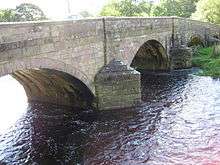 Paythorne Bridge over the River Ribble |
Paythorne Bridge | Bridge | Newsholme, Ribble Valley | The Pennine Bridleway National Trail and Ribble Way cross the River Ribble over the Paythorne Bridge. |
 Penwortham Bridge over the River Ribble |
Penwortham Old Bridge | Bridge | Preston | Built in 1759 to carry the traffic from Preston to Leyland, Liverpool and Southport. |
| Pike Low bowl barrow and site of beacon, Bonfire Hill | Burial mound | Briercliffe, Burnley | ||
| Pike Stones chambered long cairn | Cairn | Anglezarke, Chorley | ||
| Portfield hillfort | Fort | Whalley, Ribble Valley | ||
| Prehistoric defended enclosure and six adjacent hut circles at Tatham Park | Enclosure | Tatham, Lancaster | ||
| Prehistoric, Romano-British, medieval and early post-medieval settlements | Settlement | Burrow-with-Burrow, Lancaster | Including prehistoric hut circles, burial cairns (late Neolithic/early Bronze Age), field systems and a medieval deer park at High Park.
Located around Eller Beck in the Lune valley, either side of the Lancashire and Cumbria border. East of Bindloss Farm. | |
 Coke ovens at Aspen Valley Colliery, Oswaldtwistle |
Remains of Aspen Colliery | Mining | Hyndburn | And associated beehive coking ovens and canal basin |
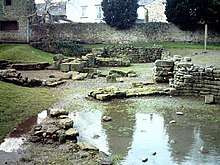 Ribchester Roman Bath Buildings |
Ribchester Roman fort (Bremetennacum) | Fort | Ribchester, Ribble Valley | |
| Ring cairn at Briercliffe | Cairn | Briercliffe, Burnley | 25m East of Ell Clough | |
| Ring cairn on Slipper Hill | Cairn | Worsthorne-with-Hurstwood, Burnley | ||
| Roman fort and civil settlement, Over Burrow | Fort | Burrow-with-Burrow, Lancaster | ||
| Roman kilns | Kilns | Quernmore, Lancaster | 20m NE of Fairyhill Cottage | |
| Roman milestone | Milestone | Leck, Lancaster | 150m SE of Overtown Farm | |
| Roman settlement and industrial area at Winery Lane | Settlement | South Ribble | ||
| Roman signal station on Mellor Moor | Building | Mellor, Ribble Valley | ||
| Romano-British enclosed hut circle settlement | Settlement | Leck, Lancaster | 375m ENE of Collingholme | |
| Round cairn at Borwick | Cairn | Borwick, Lancaster | 230m East of Manor Farm | |
| Round cairn at Earby | Cairn | Earby, Pendle | 230m West of Bleara Lowe | |
| Round cairn on Hameldon Pasture | Cairn | Worsthorne-with-Hurstwood, Burnley | ||
| Round cairn on Noon Hill | Cairn | Rivington, Chorley | ||
| Round cairn on Parlick Pike | Cairn | Chipping, Ribble Valley | ||
| Round cairn on Summerhouse Hill | Cairn | Yealand Conyers, Lancaster | ||
| Round cairn on Thornley Hall Fell | Cairn | Thornley-with-Wheatley, Ribble Valley | 430m East of Meg Hall | |
| Round cairn on Winter Hill | Cairn | Rivington, Chorley | ||
| Round Loaf bowl barrow on Anglezarke Moor | Burial mound | Anglezarke, Chorley | ||
| Rufford moated site | Moated site | Rufford, West Lancashire | ||
| Saucer barrow | Burial mound | Briercliffe, Burnley | 90m East of Ell Clough | |
 Sawley Abbey Ruins |
Sawley Abbey | Building | Sawley, Ribble Valley | Cistercian abbey and associated earthworks |
| Scarisbrick Park holy well | Well | Scarisbrick, West Lancashire | ||
Scarisbrick Wayside Cross |
Scarisbrick Park wayside cross | Cross | Scarisbrick, West Lancashire | |
| Sellet Bank prehistoric defended enclosure | Enclosure | Whittington, Lancaster | ||
| Site of Newsholme Old Hall | Building | Newsholme, Ribble Valley | Mentioned in the Domesday Book. The site now has shallow ditches around a level earth area with the hall's foundations.[6] | |
Skerton Bridge over the River Lune in Lancaster |
Skerton Bridge | Bridge | Lancaster | The bridge was completed in September 1787. It carries the Southbound lanes of the A6 road. |
| Small stone circle on Delf Hill | Henge | Briercliffe, Burnley | ||
| Spigot mortar (Blacker Bombard) position | Military | Hapton, Burnley | Anti-tank gun mounting | |
 St. Patrick's Chapel, Heysham |
St Patrick's early Christian chapel and associated cemetery | Building | Lower Heysham, Lancaster | |
| Stock medieval settlement | Settlement | Bracewell and Brogden, Pendle | And part of its associated medieval open field system | |
| Stone circle on Summerhouse Hill | Henge | Yealand Conyers, Lancaster | ||
 Thieveley Lead Mine, Cliviger |
Thieveley lead mine | Mining | Cliviger, Burnley | 330m SW and 910m WSW of Buckleys |
 Saxon cross in the churchyard of St. Mary and All Saints at Whalley |
Three high crosses in St Mary's churchyard | Cross | Whalley, Ribble Valley | |
| Torrisholme bowl barrow | Burial mound | Morecambe, Lancaster | ||
| Twist Castle Romano-British farmstead | Castle | Briercliffe, Burnley | ||
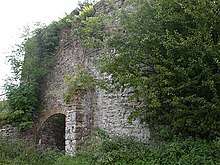 Large disused roadside limekiln at Twiston |
Twiston lime kiln and associated tramway | Kilns | Twiston, Ribble Valley | 250m East of Twiston Mill |
| Two Romano-British farmsteads known as Ring Stones | Settlement | Worsthorne-with-Hurstwood, Burnley | ||
| Univallate prehistoric defended enclosure, hollow way and secondary enclosure | Enclosure | Claughton, Lancaster | 250m North of Claughton Hall | |
 The Church of St Thomas the Martyr, Upholland |
Up Holland Benedictine priory | Building | Up Holland, West Lancashire | The remaining standing ruins of the priory are on the South side of the present Church of St Thomas the Martyr at Up Holland, which served as the priory's church in the Middle Ages. A religious college existed on the site before the priory was built. |
| Warren at Everage Clough | Habergham Eaves, Burnley |
A medieval rabbit-breeding warren in Copy Wood. 450m NE of New Copy Farm | ||
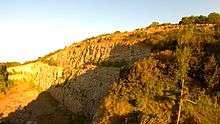 Warton Crag Quarry |
Warton Crag small multivallate hillfort | Fort | Warton, Lancaster | Iron Age hillfort |
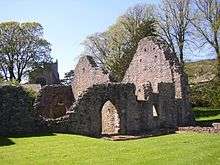 The Old Rectory at Warton |
Warton Old Rectory | Building | Warton, Lancaster | The ruins of a 14C stone house that was the residence and courthouse of the rectors of Warton. |
| Whalley Bridge | Bridge | Billington and Langho, Ribble Valley | Whalley Bridge spans the River Calder and is first mentioned in 1317. In 1634 an order to rebuild the bridge was made. A major overhaul was completed in 1917 when the traditional pointed cutwaters were replaced with rounded ones.[7] | |
 Whalley Abbey near Billington |
Whalley Cistercian abbey | Building | Whalley, Ribble Valley | |
| Whittington motte and bailey castle | Castle | Whittington, Lancaster | One of several similar Norman fortifications along the River Lune valley | |
 Clapper Bridge Over Wycoller Beck |
Wycoller Bank House Bridge | Bridge | Trawden Forest, Pendle | Also called the Clam Bridge. Formed from a single span slab of millstone grit. Probably dates from the 15th or 16th century.[8] |
 Wycoller Hall Ruins |
Wycoller Hall | Building | Trawden Forest, Pendle | Wycoller Hall dates back to the end of the 16th century. The Cunliffe family settled at the estate in the 1720s. |
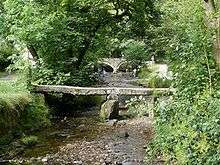 Hall Bridge over Wycoller Beck |
Wycoller Hall Bridge | Bridge | Trawden Forest, Pendle | Also known as Druids’ Bridge or Weavers’ Bridge. Basic Clapper bridge structure of three big gritstone slabs supported by two upright stones, from the 16th-17th century.[8] |
 Packhorse Bridge over Wycoller Beck |
Wycoller packhorse bridge | Bridge | Trawden Forest, Pendle | Medieval arched bridge from C13th to C15th. Also known as Sally's Bridge (named after a member of the Cunliffe family who lived in Wycoller Hall in C18th).[8] |
References
- "The Schedule of Monuments". PastScape. Retrieved 4 February 2009.
- "Archaeological activities undertaken by English Heritage". English Heritage. Archived from the original on 26 November 2006. Retrieved 15 February 2009.
- "Search the List - Find listed buildings | Historic England". historicengland.org.uk. Retrieved 12 February 2020.
- "Edisford Bridge, Clitheroe". Lancashire Past. 5 April 2018. Retrieved 21 February 2020.
- sunbright57 (25 June 2017). "Watersheddles Cross, Near Scar Top, Lancashire-Yorkshire Border". The Journal Of Antiquities. Retrieved 16 February 2020.
- "Newsholme Old Hall, Newsholme |". www.greenlanearchaeology.co.uk. Retrieved 21 February 2020.
- "Whalley Bridge, Whalley |". www.greenlanearchaeology.co.uk. Retrieved 16 February 2020.
- sunbright57 (20 January 2016). "The Three Ancient Bridges, Wycoller, Lancashire". The Journal Of Antiquities. Retrieved 16 February 2020.